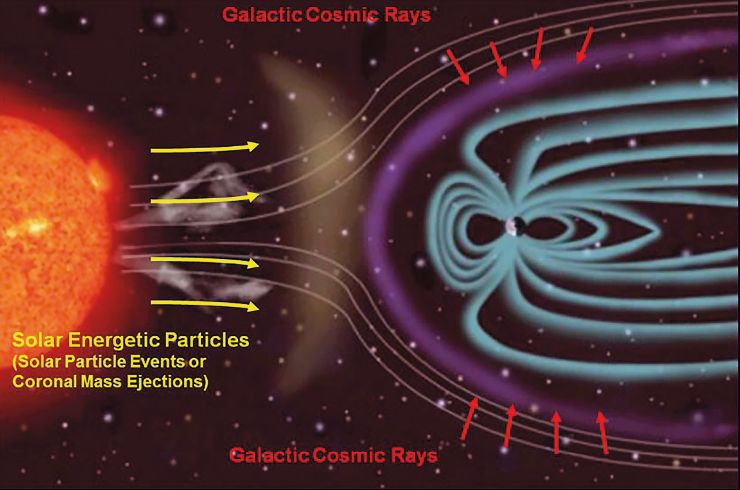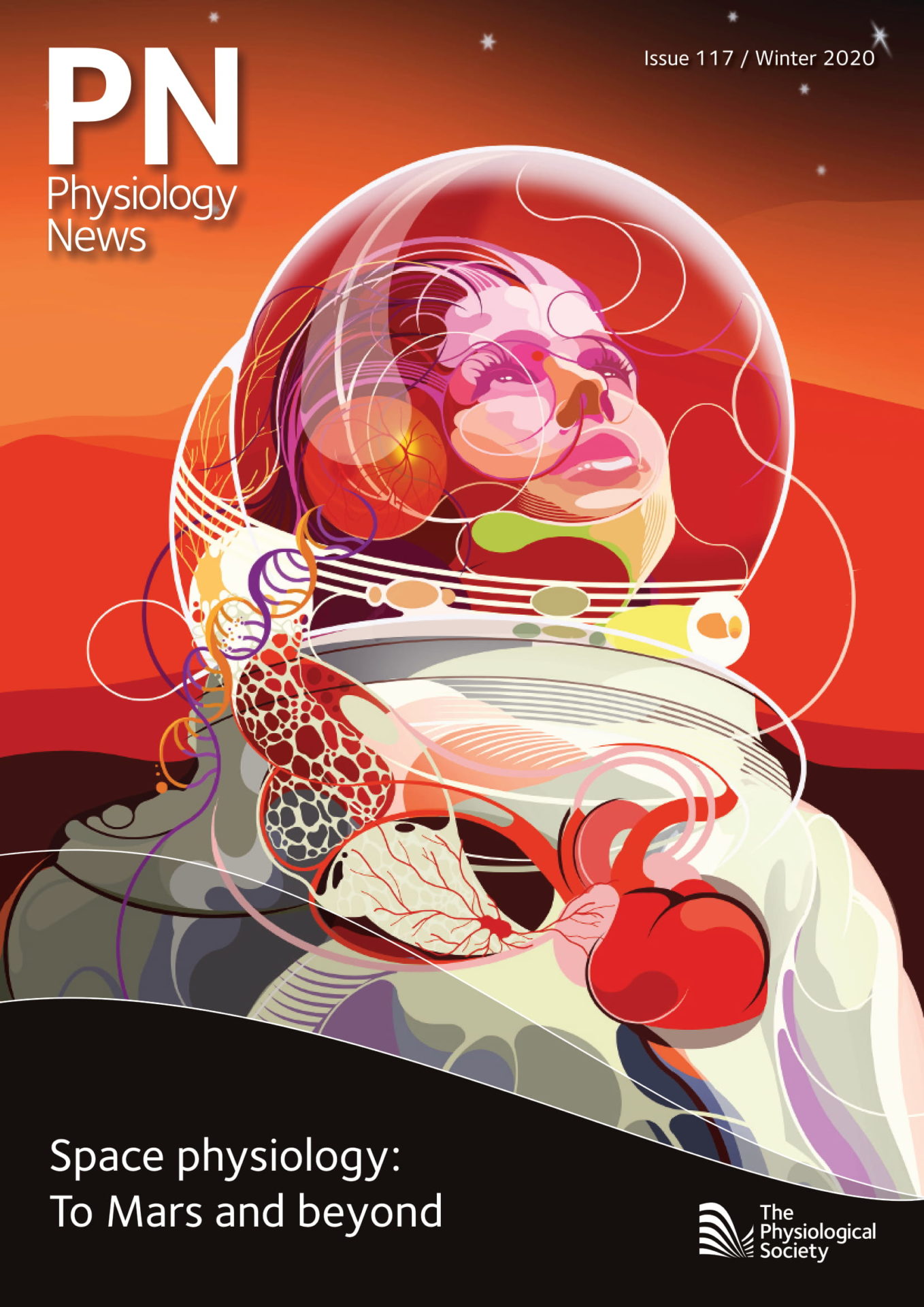
Physiology News Magazine
The invisible space killers
The dangers of space radiation from both inside and outside the solar system
Features
The invisible space killers
The dangers of space radiation from both inside and outside the solar system
Features
Ian Whittaker
Nottingham Trent University, UK
https://doi.org/10.36866/pn.117.36
When we talk about dangerous radiation on Earth the public generally think of short-wavelength electromagnetic radiation such as X-rays and gamma rays. While there are many environmental challenges to the physiology of space travellers, the biggest danger comes from ionising high-energy particles which literally “punch” through spacecraft shielding and cause numerous problems for the human body. But where does this radiation come from and how much danger is there?

Even before the advent of the space race, there was interest in exploring far-off worlds. This included an application form for an interplanetary tour reservation in the magazine “Popular Science Monthly” in August 1952. The names and addresses were to be kept on file at Hayden Planetarium ready for the first space trip. The form even had checkboxes for which planets the applicant wanted to visit! Since then there have been visits to the moon in the 1960s and 1970s, and plans to return to the moon in every decade since.
The idea of a human presence on Mars was first suggested by Wernher von Braun in 1948 and has been the goal of space agencies ever since (Zubrin and Baker, 1991; Williamson, 2017). This destination is significantly more difficult to reach than the Moon due to the travel time and increased fuel required. The time factor means that potential Martian visitors spend longer in a very dangerous environment.
The main risk to human health during spaceflight is ionising radiation exposure, which has been well established as a cause of enhancing degenerative tissue defects when leaving the protection of the Earth’s atmosphere and magnetic field.
Of course, even without radiation there are multiple challenges to the human body during spaceflight and time off planet, including muscle loss and a decrease in bone density, as well as less obvious stressors such as the change in the day/night cycle and the effect this can have on circadian rhythms. The human body is conditioned to live on Earth well, but in any other environment, pressure and thermal control will be needed to survive. Meaning humans will always have to be enclosed in some way, whether a capsule, base, or spacesuit.
An important first step then is to understand the health risks involved in space travel due to radiation; this will aid in the development of appropriate shielding and allow maximum travel times for future space missions.
The sun as a source of danger
The sun produces a wide range of electromagnetic radiation with a peak in the visible region (specifically yellow). The short, wavelength emission changes through the solar cycle though; a process in which the sun goes from having a magnetic field like a bar magnet, to having a looped and twisted magnetic field at solar maximum, at roughly five and a half years later. The sun then returns to the bar magnet configuration over another five and a half years.
At solar maximum, areas of the sun called active regions are observed that build up solar material before ejecting them out into the solar system. Typically, we see this as a solar flare which includes a large burst of X-rays. These flares can produce X-rays up to 10% of the sun’s total brightness. While these can vary, an expected radiation dose is roughly 0.05 Gray due to the very short time of the burst of emission (Thirupathaiah et al., 2019), not enough to be imminently lethal on its own.
Far more dangerous are the particles which follow such an event called a coronal mass ejection (CME) (Fig. 1). These are very dense clouds of solar material (primarily hydrogen and helium, but many heavier elements are present too) emitted at the same time as the flare. However, while it takes only a few minutes for the X-rays to reach Earth, the CME takes from two to four days to arrive. The impact of CMEs on Earth have been responsible for massive infrastructure damage due to ground-induced currents. Our ability to predict these types of events are still limited. For instance, an immensely strong CME in 2012 which narrowly missed the Earth was only detected because it hit a near-Earth solar observing satellite (Ngwira et al., 2013). The predicted infrastructure damage if this had been a direct event is estimated to be roughly $2 trillion USD. While these events are rare, they pose a serious risk to humans in space as the Earth’s magnetic field is not there to protect them.

A CME can also be accompanied by the emission of highly energetic protons, termed a Solar Proton Event or Solar Particle Event (Fig. 1 and 2). These protons are accelerated up to several GeV (a speed very close to the speed of light), and these events can last from a few hours to several days. A specific proton event in 1972 was calculated to result in absorbed dose rates of 1.4 Gy/h (Parsons and Townsend, 2000). An astronaut exposed to this event would develop radiation sickness within half an hour of exposure and, probably, neurovascular death within 14 hours of exposure.

This is immensely scary as there is very little that astronauts can do to protect themselves. These are directed beams though and – because of the distance from the sun to the Earth – an astronaut would have to be very unlucky to be hit continuously by this form of radiation.
The Earth surely only protects us?
Another source of ionising radiation is actually generated on the Earth. The Van Allen radiation belts were first discovered in 1958 when the Satellite Explorer 1 was launched (Fig. 3). This satellite had an on-board Geiger counter and was designed to measure cosmic radiation; discovering the radiation belts was a complete accident!

These radiation belts exist because charged particles get trapped within two distinct regions of the Earth’s magnetic field at high altitudes, these generally sit at between 700 and 10,000 km above the equator (inner belt) and between 13,000 and 60,000 km above the equator (outer belt) The altitudes are given above the equator as they come closer to the surface at increasing latitude. The outer belt is also significantly more dangerous than the inner belt. As the particles bounce back and forth along the field lines they increase in speed and become dangerous. Solar activity and CME impact can rapidly increase the danger of the radiation belts to astronauts. Especially as high solar activity can move the radiation belts radially inwards and outwards from the Earth, depending on the strength of the solar magnetic field. Normally, these radiation belts produce only the equivalent dose of a medical X-ray for a spacecraft travelling through them in as short a path as possible (on average ~70 mGy a day). The danger comes from either staying too long in one of these belts or travelling during a solar storm. For unmanned high-altitude satellites which orbit through the radiation belts this radiation is mitigated by switching all equipment off and lowering thick shielding to reduce instrument damage.
The dangers of the radiation belts were known before the Apollo missions were launched and the mitigation method was to just get through them as fast as possible. There have been near misses. For instance, one of the strongest solar events observed occurred in August 1972 between the launches of Apollo 16 and Apollo 17. If the launch of either had been moved by a few months it could have resulted in a fatal accident. The Apollo 11 capsule returned on 24 July 1969 and the radiation belts had been quiet during the trip; but a geomagnetic storm which occurred only two days later could have given a very different end to the astronauts if they had been delayed at any point in the mission.
Cosmic rays
Galactic Cosmic Rays (GCR) is the final source of ionising radiation in our solar system, and the only one to originate outside (Fig. 1). GCR are very energetic particles which are thought to be ejected from supernovae and collapsing stars, and consist mostly of protons and alpha particles (which are ionisied helium atoms); the rarer heavier ions are referred to as HZE (literally high [H] atomic [Z] energy [E]) particles, which are heavier high-energy charged elements, moving at relativistic speeds which have been completely ionised.
The rate at which GCR arrive in the solar system also depends on our solar activity. Towards solar maximum, the magnetic fields of the sun flow outwards faster, which acts to deflect GCR away from us and makes the solar system safer. As previously mentioned though, solar maximum is when the most solar energetic particle events occur so there is a risk with whatever part of the solar cycle you choose to travel in.
We are largely protected from the worst effects of GCR by our dense atmosphere on Earth. The discovery of cosmic rays was made in 1912 during a high-altitude balloon flight and ever since then high-altitude balloons have been used to measure the level of GCR. Although, what the balloons are measuring is not in fact the rays themselves but the secondary particles produced when rays interact with the atmosphere. These particles, as they are travelling so fast, actually show evidence of time dilation, where time is moving slower for the particle than the observer (which for physicists such as myself is fascinating).
While we are protected on Earth, there is no such protection in space. The relative vacuum of space compared to the Earth’s atmosphere means that any cosmic rays not deflected by the sun’s magnetic field at the edge of the solar system will be largely unimpeded from striking a spacecraft. This radiation is also a major concern for lunar landings or permanent bases as the moon has no atmosphere to protect it either.
The risk for astronauts from GCR is a heavily studied topic, and current guidelines suggest that astronauts should not receive more than a 3% lifetime excess risk of cancer mortality. A study by Cucinotta and Durante (2006) gave the percentage of this fatal risk allowance being achieved in different scenarios. In the case of a 180-day lunar mission, the lifetime excess risk from GCR is relatively low at an average 0.7%. In comparison, a Mars exploration mission of 1,000 days (allowing roughly one year on the surface) gave an average risk of 4.6%, suggesting one in every 20 missions could be fatal without protection!
Mitigating the danger
The best approach to avoiding space radiation is simply to not be there. Travelling to other bodies in the solar system is not a simple concept as straight-line travel is close to impossible. To reach the moon or another planet the most fuel-efficient path involves performing many orbits of varying shape, until the target is reached (known as Hohmann transfers). Any spacecraft starts by orbiting the Earth, requiring no fuel once the orbit is reached, firing rockets at any point turns your orbit more or less elliptical depending on the direction of thrust. The orbit transfer process makes this ellipse large enough to encompass both the Earth and the target then reduce the size of the orbit to only include the target object. This process takes a lot of time; thus, increasing the risk of exposure for anybody onboard.
Shielding is employed in most space missions, but only limited amounts can be installed due to the weight. To reach orbit from a planetary surface using current technology, a rocket has to be mostly fuel with only a very limited weight allowance for the payload (in this case humans and their capsule). This weight budgeting results in most shielding being a thin layer (10s of mm) of aluminium as it is one of the lightest shielding materials available. The thickness of the shielding is the biggest factor in human protection, the ISS shielding blocks a large proportion of the low-energy radiation, although this is because it sits at a very low altitude (~500 km). Still, the personal dosimeters range from 12 to 29 mRads a day.
Thicker shielding can also be problematic though; while it would stop a much higher proportion of low-energy radiation, the high-energy ionising radiation would also start to be absorbed by it. This high-energy radiation is usually travelling fast enough that the probability of interaction is low, when they do hit shielding (or humans), they create dangerous secondary particles.
An alternative to shielding is active magnetic field protection. This may seem like a sci-fi concept but research has been ongoing since the 1960’s in this field. The idea of a magnetic shield works well against solar proton events but models suggest it is largely useless against GCR. A design from the late 1970s intended to use a magnetic field to protect against GCR and calculated that the shield would weigh more than 1 million tons, and was 100 m square in size (Paluszek, 1978)! Something largely impractical for a spacecraft but potentially possible for a colonisation attempt.
For short-term missions, the risks to astronauts are relatively low. When we want to explore further afield, the health risk from radiation will increase tremendously. While new solutions are being researched, no specific mitigation method is currently available; the protection of our space explorers should be our primary concern as we move into the era of planetary visits and commercial space flights.
References
Cucinotta FA, Durante M (2006). Cancer risk from exposure to galactic cosmic rays: implications for space exploration by human beings. Lancet Oncology 7, 431 – 435. DOI: 10.1016/S1470-2045(06)70695-7.
Ngwira CM et al. (2013). Simulation of the 23 July 2012 extreme space weather event: What if this extremely rare CME was Earth directed? Space Weather 11, 671 – 679. DOI: 10.1002/2013SW000990.
Paluszek MA (1978). Magnetic radiation shielding for permanent space habitats. The industrialisation of space: Proceedings of the twenty-third annual meeting. American Astronautical Society. 36, 545 – 574.
Parsons JL, Townsend LW (2000). Interplanetary crew dose rates for the August 1972 solar particle event. Radiation Research 153, 729 – 733. DOI: 10.1667/ 0033-7587(2000)153[0729:icdrft]2.0.co;2.
Thirupathaiah P et al. (2019). Characteristics of solar X-ray flares and their effects on the ionosphere and human exploration to Mars: MGS radio science observations. Icarus 330, 60 – 74. DOI: 10.1016/j.icarus.2019.04.015.
Williamson M (2017). Missions to Mars. Engineering and Technology 12(5), 54 – 57. DOI: 10.1049/et.2017.0507.
Zubrin R, Baker D (1991). Humans to Mars in 1999. Space transportation propulsion technology symposium 3, 881 – 891. Available at: https://ntrs.nasa.gov/archive/nasa/casi.ntrs.nasa.gov/19910018923.pdf [Accessed 25 Oct 2019].
